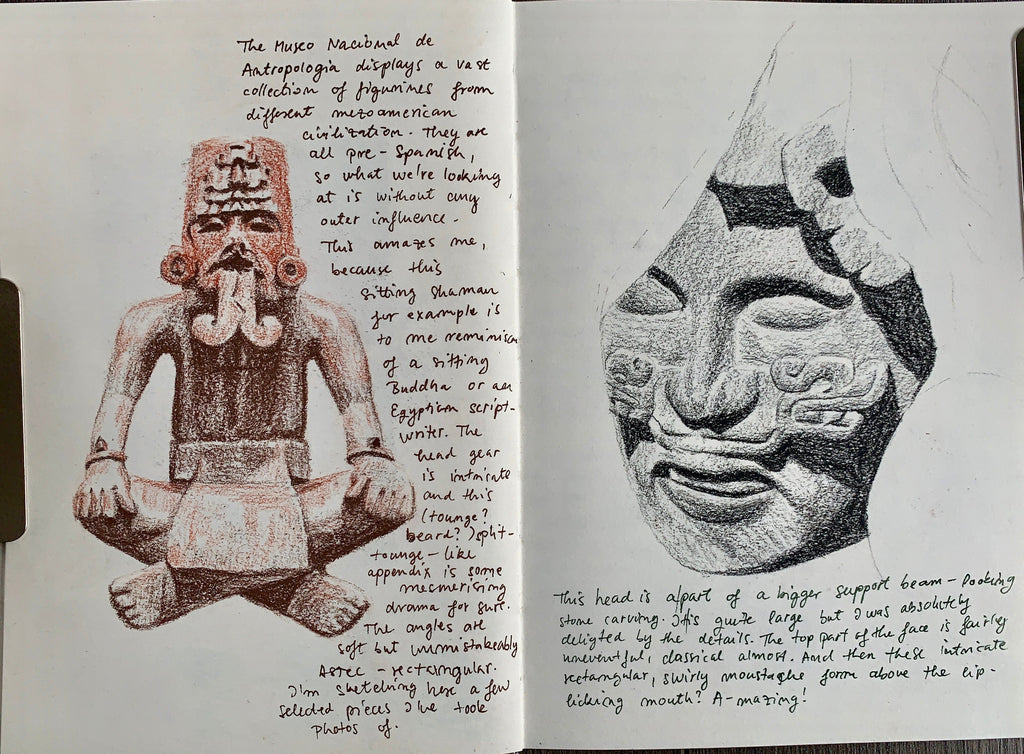The anthropological aspect of art has always intrigued me. Going to such museums sparks that curiosity of "where did this come from" and surprise me with "oh this existed centuries ago".
The Museo de Antropologia in Mexico City is a modern U-shaped building in the middle of a park that walks you through the history of the Mezoamerica. The collection is massive and I must admit my focus was waning between the different jade and clay sculptures by the time I got to the end of it.
The pieces that would sprout me back to life deserve a lot of attention. The sculpture work is vastly different from their Western and Eastern culture counterparts, yet follows a similar sociological and ideological pattern. There are deities, there are everyday people, and there are shamans and upper classes in between.

What I was first amazed by are the angular, rounded-corner patterns that tie all the carvings together on a single piece. Like going through a maze, there isn't a loose leaf in sight. All the ritual altars, all the maize mills have a story told on the sides, one irresistibly reminiscent of a comic book. The only difference is their linear continuity eventually connects.

This whole idea of circular nature of time is reiterated in the way their language worked, without big distinctions between years, and their calendars themselves representing a wheel of time.

I am reminded of a beautiful game I used to play, Guacamelee, that was a digital love letter to the Lucha Libre culture, and it adapts this linear story telling to advance the 2D platform of the game. The geometric characters are undoubtedly Mexican, and the background ornaments fill out both the foreground and the background plane with local folklore.
Looking at the carved column I am reminded of my own design work with icons, and more specifically the advent of Apple's signature rounded corners in pictography of our modern computer language. Even in their early full skeuomorphic glory, the Apple "squircle" kept them all tidy and satisfying to the eye.

My favourite part of the collection was more about sociology than iconography, though. I was blown away by the variety of human figures and the range of emotion they display. There are little figurines showing everyday people in relaxed moments, women cradling their babies, men sitting and smoking by the fire, and even people playing with their dogs.
The facial expressions are the most interesting here, because again they use simple, comic-like style to show complex emotion. I am both amused and amazed that it all transcends centuries and continents and resonates with myself, culturally far removed from pre-Colombian Mexico.

If you wish to see a more luxurious lifestyle, just take a look at elaborate shaman head gears and their statuesque poses. I wonder when did people start putting crowns on their heads to signal authority, and why does it appear all throughout human history, in every culture?
Animals are are widely covered, mythological and otherwise as pets. Seemingly a struggle for any pre-modern artist, the dogs are funnily rendered but full of expression, and the ducks and armadillos nothing short of brilliant. Dragon heads are reminiscent of those I've seen in Thailand and Cambodia, with their large eyes and even larger muzzle, seemingly fitted in an invisible rectangular box.
One of the symbols of Mexico, beautifully used as a logo for Aeromexico, is the Eagle Knight. I was most impressed with was this nacre-covered iridescent head of such knight.

Covering of sculptures in precious stones is not unusual, but these covered human skulls are what sets the pre-Colombian sensitivities apart. This wonderfully macabre sense of humour, a sense of life I'd call it, is prevalent in all of Mezoamerican civilizations. Tossed aside to the fringes of the culture by the advent of Spanish Christian sensibilities, they were brought back in full force in early 20th century with a newfound national pride, propped up in great deal by artists such as Frida Khalo and Diego Rivera.

I am touched by this honest, lighthearted acceptance of the human mortality much more than Western culture's preference of avoidance by mysticism. To continue with this topic it would be impossible to exclude the work of Frida Khalo, so I'm linking my reflection on the visit to Khalo's Casa Azul here.

